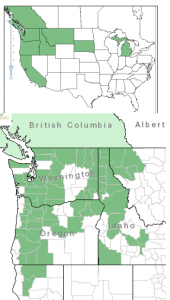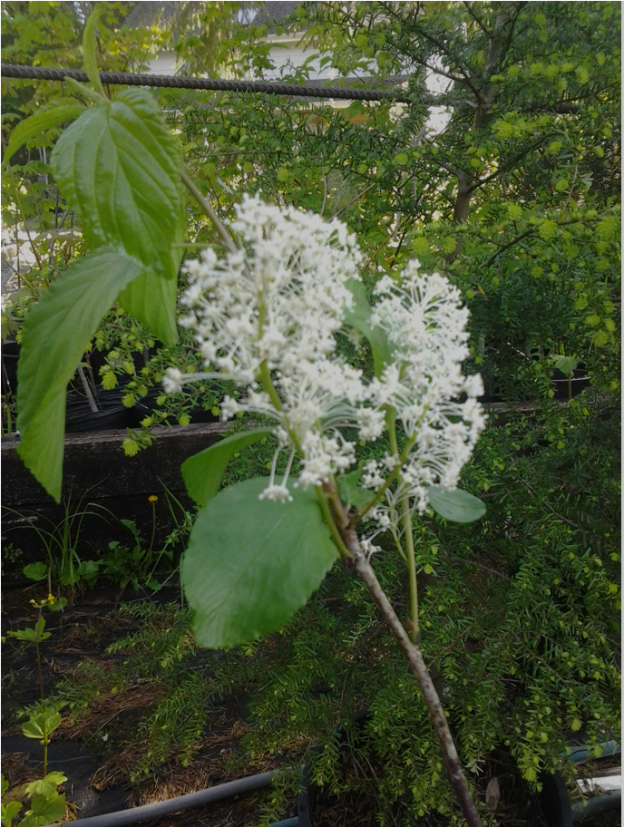Redstem Ceanothus Rhamnaceae– The Buckthorn Family
Ceanothus sanguineus Pursh
(See-uh-NO-thus sang-GWIN-ee-us)
Names: Redstem Ceanothus is also known as Redstem Wild Lilac, Redstem Buckbrush, Oregon Tea Tree, Northern Buckbrush, or “Soapbloom.” Sanguineus means blood red, referring to the stems or flower stalks.
Relationships: The genus Ceanothus consists of about 60 shrubs or small trees found only in North America with about 40 occurring only in California. Many have blue or purple flowers, earning the genus the common name, “Wild Lilacs,” but our creamy white-flowered northwestern species are generally called “Buckbrushes.” Snowbrush, Ceanothus velutinus, is discussed in the evergreen shrub section. Red Stem Ceanothus is very similar to Snowbrush, it mainly differs in that it its leaves and stipules are deciduous and its stems are red.

Distribution of Red Stem Ceanothus from USDA Plants Database
Distribution: This species is native on both sides of the Cascades from British Columbia to northern California; eastward to western Montana, with reported occurrences in South Dakota and on the shores of Lake Superior in Michigan (Listed as threatened in Michigan).
Growth: It grows 3-9 feet (1-3m) tall .
Habitat: This species grows in dry open sites and forest edges, often in recently burned areas. Wetland designation: It almost always occurs in non-wetlands areas in our region.
Diagnostic Characters: The leaves of Redstem Ceanothus are thinner than those of C. velutinus; but similarly are finely toothed and oval with 3 main veins branching from the base of the leaf. Flowers are fragrant, small and white in clusters at the ends of side branches. Fruits are 3-chambered explosive capsules, each with a shiny brown seed. Smooth, greenish stems turn purplish-red.
In the Landscape: The white flowers are showy in early summer and the reddish stems are attractive in the winter. Redstem Ceanothus also is able to fix nitrogen so is good for areas with poor soils.
Phenology: Bloom time: May-July; Capsules ripen: June-August.
Propagation: Seeds usually germinate after a fire. They have a hard seed coat and dormant embryos; and require heat (185-212º F, 85-100º C) or treatment with sulfuric acid for 20 to 30 minutes followed by a neutralization of lime or by water and a 48 hour running water soak; then a 90 day cold stratification period. Semi-hardwood cuttings in May have the best success, treated with 2000ppm IBA and placed in a mist bed with bottom heat.—just the right amount of moisture is critical—too much and the cuttings will rot. This plant is not often available nurseries due to its difficult propagation requirements.
Use by People: A tea has been made from the leaves; a poultice of the dried, powdered bark has been applied to burns, sores and wounds; and a green dye was made from the flowers. It was called “Soapbloom” because all parts of the plant contains saponin, and was mixed with water and beaten into a soapy foam. The foam is good for cleaning dirt but does not remove oil; so it will not dry skin. The flowers, especially, were nice for use as a body soap because of their pleasant perfume. Natives burned the wood for fuel and to smoke deer meat.
Use by Wildlife: Redstem Ceanothus is a favorite browse species of elk and deer as are other Buckbrushes. Snowshoe Hares also eat the foliage and rodents eat the seedlings. Birds, rodents, ants, and other insects consume large amounts of the seeds. The shrub provides good cover for birds and small mammals. Flowers are pollinated by bees. Ceanothus sanguineus is a larval host for the Pale Swallowtail Butterfly.
Links:
Consortium of Pacific Northwest Herbaria
WTU Herbarium Image Collection, Plants of Washington, Burke Museum
E-Flora BC, Electronic Atlas of the Flora of British Columbia
Jepson Eflora, University of California
Ladybird Johnson Wildflower Center
USDA Forest Service-Fire Effects Information System
Native Plants Network, Propagation Protocol Database
Native American Ethnobotany, University of Michigan, Dearborn
Deerbrush , Ceanothus integerrimus, is another similar species found from the Columbia River Gorge in Washington State to Baja California; also in Arizona and New Mexico. Integerrimus means completely entire, not toothed, referring to its leaves. Deerbrush grows in dry, open forests; it is drought-deciduous, meaning that most leaves are shed during dry summers and a few leaves are retained throughout winter. It has white, pink, lilac, or pale blue pyramidal clusters of flowers. Deerbrush could make an attractive addition to a dry garden, but should be avoided in moister areas. Its shoots were used by natives for basketry. Deerbrush is a valuable honey plant, and as the common name suggests, is an important browse species for deer.
Links:
Consortium of Pacific Northwest Herbaria
WTU Herbarium Image Collection, Plants of Washington, Burke Museum
Jepson Eflora, University of California
Ladybird Johnson Wildflower Center
USDA Forest Service-Fire Effects Information System
Native Plants Network, Propagation Protocol Database
Native American Ethnobotany, University of Michigan, Dearborn

